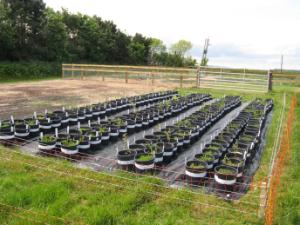News & Events
Plant Growth Experiment

Following the successful completion of the geotechnical experimental plots in April, another SUCCESS experiment is now up and running at Cockle Park Farm.
The new experiment has seen 232 pots planted up with 25 different plant species to examine which types of plant will grow best in engineered soils designed to capture carbon. The experiment includes a range of plant functional groups, such as grasses, trees and herbaceous plants, as well as some species that are grown as energy crops. SUCCESS Ecology specialist Dr Mark Goddard describes what the experiment aims to achieve
“Similar to the larger experimental plots situated next door, the plant growth experiment makes use of two main soil substrates – crushed concrete and dolerite quarry fines – which are known to have great potential for capturing carbon inorganically as calcium carbonate. However, these substrates are very low in nutrients and we want to find out which plants are best at surviving in these harsh conditions. Of those plants that can survive, we are also interested in ability of different plants to boost the carbon storage capability of the soil. For example, we may expect that woody species with deep roots will be the most effective at drawing CO2 into the soil.”
“The experiment employs a rigorous fully factorial random block design which involves each species being planted on their own in each of the two substrates and replicated four times in a random layout within four blocks. The experiment will run for the next 18 months with plant performance (i.e. survival and height) monitored regularly. Soil samples will be collected this autumn and again next autumn to examine the amount of carbon that has been captured in the different experimental treatments. At the end of the experiment we will also look at the total growth of the plants in each pot as a measure of their performance over the course of the experiment.”
“We hope that this experiment will be a forerunner to recommending designer plant communities as part of ‘carbon capture gardens’ in new urban developments or construction projects. Such carbon capture gardens will have the potential to be multifunctional, delivering other ecosystem services such as biodiversity conservation, recreation or bioenergy production.”
For images of the construction of the plant growth experiment, check out our gallery.
Find us on Twitter and Like our Facebook page using the buttons below.
Last modified: Wed, 01 Jul 2015 15:53:22 BST





